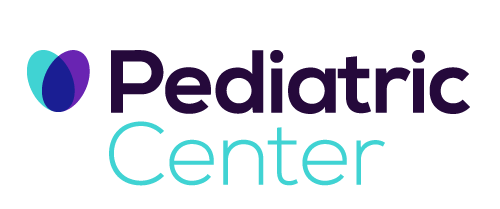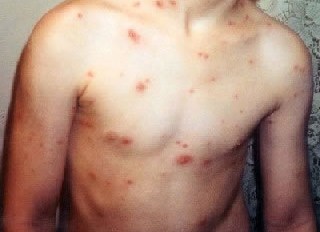Comprehensive Care
The Pediatric Center has a dedicated team of 5 Pediatricians and 4 Nurse Practitioners committed to providing exceptional care for your children.
Rash or Redness – Widespread
See More Appropriate Topic (instead of this one):
- If NOT, try one of these: Chickenpox
- If NOT, try one of these: Hand-Foot-And-Mouth Disease HFMD
- If NOT, try one of these: Roseola
- If NOT, try one of these: Eczema
- If NOT, try one of these: Sunburn
- If NOT, try one of these: Hives
- If NOT, try one of these: Immunization Reactions
Is this your child’s symptom
- Rash over large parts or most of the body widespread
- Sometimes, just on hands, feet and buttocks – but same on both sides of body
- Red or pink rash
- Small spots, large spots or solid red skin
Causes of Widespread Rash or Redness
- Viral Rash. Most rashes are part of a viral illness. Viral rashes usually have small pink spots. They occur on both sides of the chest, stomach and back. Your child may also have a fever with some diarrhea or cold symptoms. They last 2 or 3 days. More common in the summer.
- Roseola. This is the most common viral rash in the first 3 years of life. See details below.
- Chickenpox. A viral rash with a distinctive pattern. see that Care Guide
- Hand-Foot and-Mouth Disease. A viral rash with a distinctive pattern. see that Care Guide
- Scarlet Fever. Scarlet Fever is a speckled, red rash all over. Caused by the Strep bacteria. Starts on upper chest and quickly spreads to lower chest and stomach. No more serious than a Strep throat infection without a rash.
- Drug Rash. Most rashes that start while taking an antibiotic are viral rashes. Only 10% turn out to be drug rashes. see details below
- Hives. Raised pink bumps with pale centers. Hives look like mosquito bites. Rashes that are bumpy and itchy are often hives. Most cases of hives are caused by a virus. Hives can also be an allergic reaction. See that Care Guide for details
- Heat Rash. A fine pink rash caused by overheating. Mainly involves neck, chest and upper back.
- Insect Bites. Insect bites cause small red bumps. Flying insects can cause many bumps on exposed skin. Non-flying insects are more likely to cause localized bumps.
- Hot Tub Rash. Causes small red bumps that are painful and itchy. Mainly occurs on skin covered by a bathing suit. Rash starts 12-48 hours after being in hot tub. Caused by overgrowth of bacteria in hot tubs.
- Purpura Rash Serious. Purpura means bleeding into the skin. It looks like purple or dark red spots. Widespread purpura is always an emergency. It can be caused by a bacterial bloodstream infection. Rocky Mountain Spotted Fever is an example.
- Blister Rash Serious. Widespread blisters on the skin are a serious sign. It can be caused by infections or drugs. Stevens Johnson Syndrome is an example.
- Caution. All widespread rashes with fever need to be seen. They need to be diagnosed. Reason: There are some serious infections that can cause this type of rash.
Drugs and Rashes
- Prescription medicines sometimes cause widespread rashes.
- Non-prescription OTC medicines rarely cause any rashes.
- Most rashes that occur while taking an OTC medicine are viral rashes.
- Fever medicines acetaminophen and ibuprofen cause the most confusion. Reason: Most viral rashes start with a fever. Hence, the child is taking a fever medicine when the rash starts.
- Drug rashes can’t be diagnosed over the phone.
Roseola – A Classic Rash
- Most children get Roseola between 6 months and 3 years of age.
- Rash: Pink, small, flat spots on the chest and stomach. Then spreads to the face.
- Classic feature: 2 or 3 days of high fever without a rash or other symptoms.
- The rash starts 12 to 24 hours after the fever goes away.
- The rash lasts 1 to 3 days.
- By the time the rash appears, the child feels fine.
- Treatment: The rash is harmless. Creams or medicines are not needed.
Localized Versus Widespread Rash: How to Decide
- Localized means the rash occurs on one small part of the body. Usually, the rash is just on one side of the body. An example is a rash on 1 foot. Exceptions: Athlete’s foot can occur on both feet. Insect bites can be scattered.
- Widespread means the rash occurs on larger areas. Examples are both legs or the entire back. Widespread can also be on most of the body surface. Widespread rashes always occur on matching both sides of the body. Many viral rashes are on the chest, stomach and back.
- The cause of a widespread rash usually goes through the blood stream. Examples are rashes caused by viruses, bacteria, toxins, and food or drug allergies.
- The cause of a localized rash usually is just from contact with the skin. Examples are rashes caused by chemicals, allergens, insect bites, ringworm fungus, bacteria or irritants.
- This is why it’s important to make this distinction.
Return to School
- Most viral rashes cannot be spread to others once the fever is gone.
- For minor rashes, your child can return after the fever is gone.
- For major rashes, your child can return after the rash is gone. If your doctor has given medical clearance to return, can go back sooner.
When to Call Us for Rash or Redness – Widespread
Call 911 Now
- Purple or blood-colored rash with fever
- Trouble breathing or swallowing
- Not moving or too weak to stand
- You think your child has a life-threatening emergency
Call Doctor Now or Go to ER
- Purple or blood-colored rash without fever
- Bright red skin that peels off in sheets
- Large blisters on skin
- Bloody crusts on the lips
- Taking a prescription medication within the last 3 days
- Fever
- Your daughter is having her period and using tampons
- Your child looks or acts very sick
- You think your child needs to be seen, and the problem is urgent
Call Doctor Within 24 Hours
- Widespread rash, but none of the symptoms above. Reason: All widespread rashes need to be checked by a doctor.
Care Advice for Widespread Rashes
- What You Should Know About Widespread Rashes:
- Most rashes with small pink spots all over are part of a viral illness.
- This is more likely if your child has a fever. Other symptoms like diarrhea also point to a viral rash.
- Here is some care advice that should help until you talk with your doctor.
- Non-Itchy Rash Treatment:
- If you suspect a heat rash, give a cool bath.
- Otherwise, no treatment is needed.
- Itchy Rash Treatment:
- Wash the skin once with soap to remove any irritants.
- Steroid Cream. For relief of itching, use 1% hydrocortisone cream such as Cortaid. Put it on the most itchy areas. No prescription is needed. Do this 3 times per day.
- Cool Bath. For flare-ups of itching, give your child a cool bath. Do not use soap. Do this for 10 minutes. Caution: Avoid any chill. Option: Can add 2 ounces 60 ml of baking soda per tub.
- Fever Medicine:
- For fevers above 102° F 39° C, give an acetaminophen product such as Tylenol.
- Another choice is an ibuprofen product such as Advil.
- Note: Fevers less than 102° F 39° C are important for fighting infections.
- For all fevers: Keep your child well hydrated. Give lots of cold fluids.
- Return to School:
- If your child has a fever, avoid contact with other children. Avoid pregnant women until a diagnosis is made.
- Most viral rashes can be spread to others especially if a fever is present.
- Your child can return to school after the rash is gone. If your doctor has given medical clearance, your child can return sooner.
- What to Expect:
- Most viral rashes go away within 48 hours.
- Call Your Doctor If:
- You think your child needs to be seen
- Your child becomes worse
And remember, contact your doctor if your child develops any of the ‘Call Your Doctor’ symptoms.
Disclaimer: This information is not intended be a substitute for professional medical advice. It is provided for educational purposes only. You assume full responsibility for how you choose to use this information.
Copyright 1994-2015 Barton D. Schmitt, MD. All rights reserved.
“Dr Aughney is the best. Very good with both kids and parents. My kids never have a fear to go and see him because they trust him which is so important.”
“Our family has gone to the Pediatric Center for decades. We have always been treated well by the friendly, knowledgeable staff. We love Dr. Anderson and Dr. Edwards especially, but all the doctors and nurses are fantastic! They are each compassionate and trustworthy. We recommend everyone to the Pediatric Center.“
“We love the pediatric center! Everyone is always so helpful and every physician we have seen answers all our questions and makes us feel confident in taking care of our baby!“








